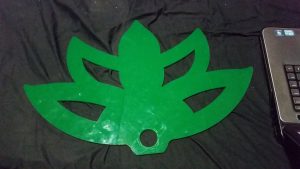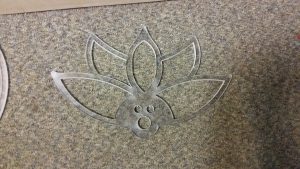Hiya! I haven’t made any posts recently, so I’ve got a backlog of a couple projects to write about. Besides personal projects, I’ve also had a lot of life updates in the past year. First, I graduated! I interned at two companies, and now I’m back at school, working on a master’s program with the Biomechatronics Group.
In contrast to all these technical endeavors, I thought I’d start off with some relatively artsy projects.
Recently, I’ve been learning to spin fire fans. A video speaks a thousand pictures, so here’s a video from my very first fire fan performance, at Steer Roast 2016. Credit to Ivan F for the video.
Prior to getting fire fans, I wanted to build some practice fans. Here’s my first prototype:
I sketched up a lotus shape in solidworks and cut the shape out of 1/4″ acrylic with a laser cutter. Acrylic is not the appropriate material for the final application — you can see this fan already has a crack in it, but I wanted something to play around with first.
Based on this version, I changed some thicknesses and cut new fans out of 1/2″ clear polycarbonate. The polycarbonate is more appropriate for the impacts that I expect these fans to take. I got polycarbonate from a lab cleanout on campus–the sheets used to be splash shields for some kind of chemical process. I used a waterjet to cut out this version
Now that I have some fire fans to compare the weight with, I’ll make some more modifications. One popular choice of material for practice fans is HDPE for its slickness. Indeed, the polycarbonate fans I made are rough on the hands. However, HDPE is very brittle for this application. I’m considering making polycarbonate fans with press-fit HDPE finger rings for my next version. I also like how the polycarbonate is translucent–I’m considering inserting LEDs in my next version to made a rave-ready pair of practice fans.
What do you think would be good features in fans like these?

